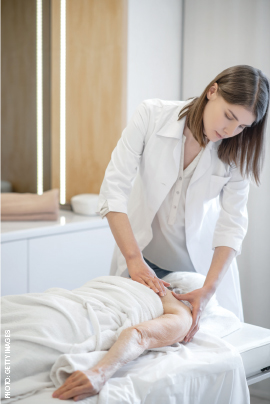Guest Editor’s Note: Pain is a debilitating symptom experienced by many patients with cancer that negatively impacts their quality of life. Massage therapy, historically used for relaxation and pain relief, plays an important supportive role in oncology settings. In this installment of The ASCO Post’s Integrative Oncology series, Colleen M. Smith, LMT; Jane S. Greene, RN, LMT; and Eva Pendleton, MA, LMT, describe the current evidence for massage therapy in the relief of pain in various cancer settings and highlight the challenges surrounding oncology massage research.

Jane S. Greene, RN, LMT

Eva Pendleton, MA, LMT
A debilitating symptom, pain is experienced by more than 55% of patients during cancer treatment and by 40% following treatment.1 As conventional options are often associated with undesirable side effects, patients increasingly seek nonpharmaceutical strategies for pain relief.2,3 Massage is a safe mind-body therapy commonly used for promoting relaxation and for relieving pain.
Current Evidence
The largest observational study of massage therapy to date, involving 1,290 patients with cancer treated over a 3-year period, reported that massage reduced pain as well as stress, anxiety, nausea, fatigue, and depression by 50%, even among patients with high baseline scores.4 Notably, the effects were smaller and less persistent for inpatients than outpatients.
A systematic review and meta-analysis of 12 high-quality and 4 low-quality randomized controlled trials found massage therapy to be effective for cancer pain management when compared with no treatment or active comparators (standardized mean difference = –0.20 and –0.055).5
Growing evidence also suggests a potential benefit of massage in reducing chemotherapy-induced peripheral neuropathy. A single-arm, prospective study of 62 patients receiving chemotherapy found that except for vestibulocochlear symptoms, a single massage therapy session resulted in 50% or greater improvement in chemotherapy-induced peripheral neuropathy—which was sustained until the second massage session. Furthermore, data suggest that patients receiving analgesics may also benefit from massage, with 66% reporting no progression or resolution of symptoms following massage.6
An additional randomized trial of 60 patients with chemotherapy-induced peripheral neuropathy found foot reflexology to be effective in managing related sensory functions (P < .05) but not in the incidence or severity of chemotherapy-induced peripheral neuropathy (P > .05).7 Reflexology also significantly affected pain perception (before and after pain score: P < .01) in a study involving 87 inpatients.8 However, conclusive evidence on the duration of this benefit is lacking. Also, there was no apparent correlation with the type of cancer or the extent of metastases. As pain has a nociceptive element, disease progression can be a significant factor.
Guest Editor

Jun J. Mao, MD, MSCE
Integrative Oncology is guest edited by Jun J. Mao, MD, MSCE, Laurance S. Rockefeller Chair in Integrative Medicine and Chief of Integrative Medicine Service at Memorial Sloan Kettering Cancer Center, New York.
Noteworthy is the study involving 692 patients with breast cancer in which integrating massage into chemotherapy infusion suites led to a significant decrease in patient-reported pain (before and after, 3.3 to 1.9) as well as fatigue (4.8 to 3.0), anxiety (3.9 to 1.7), and nausea (2.5 to 1.2) in addition to increasing relaxation. However, study participants self-selected for massage and outcome evaluation, which may have biased the benefit estimates.9
In another randomized trial of 380 patients with advanced cancer who had moderate to severe pain, of whom 90% were enrolled in hospice, massage was found to be more effective than simple touch in improving pain and mood (mean difference = 0.90 and 0.61 points, P < .001). However, there were no data on sustained outcomes.10
Safety and Clinical Considerations
Massage is generally safe when provided by a trained professional. The National Comprehensive Cancer Network Clinical Practice Guidelines in Oncology (NCCN Guidelines®) on Adult Cancer Pain recommend massage to reduce cancer-related pain.11 Many National Cancer Institute–designated cancer centers, including Memorial Sloan Kettering Cancer Center (MSK), offer massage within their integrative medicine services.12

In addition to completing oncology massage programs that prepare them to work with the cancer population,13 therapists may make patient-specific modifications based on skin integrity, metastatic disease state, platelet count, patient self-assessment of pain, and symptomology. Therapists can also adapt techniques and delivery to accommodate environments along the cancer trajectory, such as inpatient, outpatient, chemotherapy infusion suite, bedside, or seated massage.14,15 Lastly, with the emergence of new COVID-19 variants, therapists must ensure their own safety and that of their patients and fellow clinicians by following proper protocols and COVID-19 personal protective equipment guidelines.
Challenges and Future Directions
Although findings to date are encouraging, many massage studies are limited by small sample size, lack of standardized treatments, adequate controls, and uniformity in study populations. Future trials must therefore include appropriate controls, uniform treatment length, location, and techniques, as well as a strict definition of massage and consistent clinical language to help reinforce massage as a therapy.5 Furthermore, practitioner characteristics are seldom reported and may correlate with improved outcomes16-18; and underreported patient and practitioner expectations may also cause a placebo effect.
The Integrative Medicine for Pain in Patients with Advanced Cancer Trial (IMPACT), underway at MSK, aims to determine the long-term comparative effectiveness of massage vs acupuncture on musculoskeletal pain and related symptoms in patients with advanced cancer (ClinicalTrials.gov identifier NCT04095234). Trials elsewhere are also investigating the role of massage in musculoskeletal pain management (NCT03534739, NCT03100539) and evaluating how patient expectations may affect massage-related hypoalgesia (NCT04108403).
DISCLOSURE: Ms. Smith and Ms. Greene reported no conflicts of interest. Ms. Pendleton is a founding faculty member of the oncology massage certification program at the Center for the Advancement of Therapeutic Arts.
REFERENCES
1. Sheinfeld Gorin S, Krebs P, Badr H, et al: Meta-analysis of psychosocial interventions to reduce pain in patients with cancer. J Clin Oncol 30:539-547, 2012.
2. Mao JJ, Palmer SC, Straton JB, et al: Cancer survivors with unmet needs were more likely to use complementary and alternative medicine. J Cancer Surviv 2:116-124, 2008.
3. Bauml JM, Chokshi S, Schapira MM, et al: Do attitudes and beliefs regarding complementary and alternative medicine impact its use among patients with cancer? A cross-sectional survey. Cancer 121:2431-2438, 2015.
4. Cassileth BR, Vickers AJ: Massage therapy for symptom control: Outcome study at a major cancer center. J Pain Symptom Manage 28:244-249, 2004.
5. Boyd C, Crawford C, Paat CF, et al: The impact of massage therapy on function in pain populations: A systematic review and meta-analysis of randomized controlled trials: Part II, cancer pain populations. Pain Med 17:1553-1568, 2016.
6. Menendez AG, Cobb R, Carvajal AR, et al: Effectiveness of massage therapy as a treatment strategy and preventive modality for chemotherapy-induced peripheral neuropathy symptoms. 2016 Palliative and Supportive Care in Oncology Symposium. Abstract 193.
7. Kurt S, Can G: Reflexology in the management of chemotherapy induced peripheral neuropathy: A pilot randomized controlled trial. Eur J Oncol Nurs 32:12-19, 2018.
8. Grealish L, Lomasney A, Whiteman B: Foot massage: A nursing intervention to modify the distressing symptoms of pain and nausea in patients hospitalized with cancer. Cancer Nurs 23:237-243, 2000.
9. Mao JJ, Wagner KE, Seluzicki CM, et al: Integrating oncology massage into chemoinfusion suites: A program evaluation. J Oncol Pract 13:e207-e216, 2017.
10. Kutner JS, Smith MC, Corbin L, et al: Massage therapy versus simple touch to improve pain and mood in patients with advanced cancer: A randomized trial. Ann Intern Med 149:369-379, 2008.
11. National Comprehensive Cancer Network: NCCN Clinical Practice Guidelines in Oncology: Adult Cancer Pain, version 1.2022 — January 19, 2022. Available at https://www.nccn.org/professionals/physician_gls/default.aspx#supportive. Accessed January 25, 2022.
12. Yun H, Sun L, Mao JJ: Growth of integrative medicine at leading cancer centers between 2009 and 2016: A systematic analysis of NCI-designated comprehensive cancer center websites. J Natl Cancer Inst Monogr 2017:lgx004, 2017.
13. Society for Oncology Massage: Finding courses & training schedules. Available at https://www.s4om.org/education/course-training-schedules/. Accessed January 25, 2022.
14. MacDonald G: Medicine Hands: Massage Therapy for People With Cancer Paperback. Scotland; Findhorn Press; 2014.
15. Society for Oncology Massage: Oncology massage 101: An introduction to oncology massage. Available at https://www.s4om.org/resources/2337-2/s4om-insights/oncology-massage-101/. Accessed January 25, 2022.
16. Russell NC, Sumler SS, Beinhorn CM, et al: Role of massage therapy in cancer care. J Altern Complement Med 14:209-214, 2008.
17. Ezzo J: What can be learned from Cochrane systematic reviews of massage that can guide future research? J Altern Complement Med 13:291-295, 2007.
18. Furlan AD, Imamura M, Dryden T, et al: Massage for low back pain. Cochrane Database Syst Rev (4):CD001929, 2008.
Ms. Smith is Project Coordinator, Ms. Greene is Massage Therapy Program Coordinator, and Ms. Pendleton is Associate Director, Integrative Medicine, Memorial Sloan Kettering Cancer Center, New York, New York.

